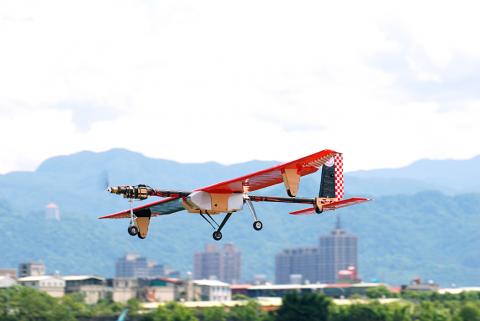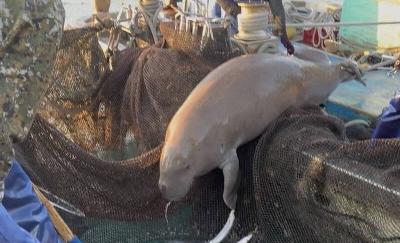Phoenix, the nation’s first solar-powered unmanned aerial vehicle (UAV), successfully made its first test flight in Taipei yesterday, showing off the results of three years of research and development by a team from the Department of Aerospace Engineering of Tamkang University.
The aircraft, which weighs about 9.3kg, has solar arrays (a group of solar panels) attached to its wings that are 3.7m long and cover 65 percent of the wing surface. The solar panels, which operate at 18 percent efficiency, cannot produce sufficient energy to power the drone, so two lithium polymer batteries provide the remaining energy needed to keep the aircraft aloft.
Phoenix has not yet been able to store solar energy in fuel cells for use at night.

Photo: Tsai Pai-ling, Taipei Times, courtesy of Tamkang University’s Department of Aerospace Engineering
“The most difficult part of the project is to design and build a system that utilizes as well as maximizes energy,” said Ma Te-ming (馬德明), an associate professor at the department. “We have developed our own software to achieve the best efficiency possible.”
Ma also said Phoenix could harvest all its power from the sun if solar panels that operate at 30 percent efficiency are used. However, the limited funding provided by the university and the National Science Council means that the researchers need to make the most with what funding they have.
“A 3x7cm panel that is 30 percent efficient costs NT$10,000. We can’t afford it. The total amount we spent on solar panels is around NT$30,000,” he said. “The total cost of the drone is around NT$100,000.”
Composed of about 30 students from two aerial engineering laboratories amd led by three academics, including Ma, the university’s team made a couple of test models before Phoenix.
“My job is to develop the solar energy system. It took forever to set up the system. After it was set up, we spent another year running tests,” 25-year-old team member Liang Chun-kang (梁淳剛) said.
Under the midday sun at the His Sheng Remote Control Aircraft Park in New Taipei City’s (新北市) Sinjhuang (新莊) yesterday, the UAV took off on an airstrip as the research team piloted it by remote control. It flew at an average speed of 34km per hour, circled in the sky a few times and made a slightly rough landing that caused minor damage to one of its tires.
The range of the remote control is one to two kilometers, Ma said, adding the aircraft’s slow velocity renders it vulnerable to crosswinds.
The test flight is expected to provide valuable data relating to battery voltage, electric current, flight height, aircraft motions for further development.
The ultimate goal, Ma said, is to make an entirely solar-powered aircraft, with solar panels feeding on batteries that can keep the craft aloft at night or in the rain.
One of the main reasons for developing solar-powered UAVs is to extend aircraft flight times because they can use the sun as an unlimited source of energy, Ma said.
“Because UAVs don’t need human pilots, we want to keep them up in the air as long as possible to carry out operations considered too dangerous for manned aircraft,” he added.
UAVs have a wide range of uses and mission capabilities beyond military purposes. For example, they can be used for search-and-rescue operations, monitoring drug trafficking and detecting pollution, Ma said.

‘DENIAL DEFENSE’: The US would increase its military presence with uncrewed ships, and submarines, while boosting defense in the Indo-Pacific, a Pete Hegseth memo said The US is reorienting its military strategy to focus primarily on deterring a potential Chinese invasion of Taiwan, a memo signed by US Secretary of Defense Pete Hegseth showed. The memo also called on Taiwan to increase its defense spending. The document, known as the “Interim National Defense Strategic Guidance,” was distributed this month and detailed the national defense plans of US President Donald Trump’s administration, an article in the Washington Post said on Saturday. It outlines how the US can prepare for a potential war with China and defend itself from threats in the “near abroad,” including Greenland and the Panama

A wild live dugong was found in Taiwan for the first time in 88 years, after it was accidentally caught by a fisher’s net on Tuesday in Yilan County’s Fenniaolin (粉鳥林). This is the first sighting of the species in Taiwan since 1937, having already been considered “extinct” in the country and considered as “vulnerable” by the International Union for Conservation of Nature. A fisher surnamed Chen (陳) went to Fenniaolin to collect the fish in his netting, but instead caught a 3m long, 500kg dugong. The fisher released the animal back into the wild, not realizing it was an endangered species at

The High Prosecutors’ Office yesterday withdrew an appeal against the acquittal of a former bank manager 22 years after his death, marking Taiwan’s first instance of prosecutors rendering posthumous justice to a wrongfully convicted defendant. Chu Ching-en (諸慶恩) — formerly a manager at the Taipei branch of BNP Paribas — was in 1999 accused by Weng Mao-chung (翁茂鍾), then-president of Chia Her Industrial Co, of forging a request for a fixed deposit of US$10 million by I-Hwa Industrial Co, a subsidiary of Chia Her, which was used as collateral. Chu was ruled not guilty in the first trial, but was found guilty

DEADLOCK: As the commission is unable to forum a quorum to review license renewal applications, the channel operators are not at fault and can air past their license date The National Communications Commission (NCC) yesterday said that the Public Television Service (PTS) and 36 other television and radio broadcasters could continue airing, despite the commission’s inability to meet a quorum to review their license renewal applications. The licenses of PTS and the other channels are set to expire between this month and June. The National Communications Commission Organization Act (國家通訊傳播委員會組織法) stipulates that the commission must meet the mandated quorum of four to hold a valid meeting. The seven-member commission currently has only three commissioners. “We have informed the channel operators of the progress we have made in reviewing their license renewal applications, and